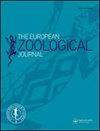Impact of water level on spring bird assemblages in a natural river valley in central Europe
IF 1.6
4区 生物学
Q2 ZOOLOGY
引用次数: 0
Abstract
Abstract Water level appears to be crucial for waterbirds, especially in the changeable conditions prevailing in river valleys. One of the best preserved Central European rivers is the Biebrza in north-eastern Poland, which seasonally overflows in spring, creating optimal habitats for various waterbirds. We examined a number of environmental factors which could strongly influence different foraging groups and bird assemblages with respect to water surface area and depth. Number of waterbirds peaked during the second half of March, when a large wave of geese and ducks stopped over there. The species diversity was the greatest in the first half of April, when more species arrived from their wintering grounds. We did not find any relationship between water depth and total abundance, but the former did significantly influence the numbers of some ecological feeding groups of waterbirds, i.e. diving omnivores, diving carnivores and surface carnivores. We assume that higher water level in a river valley is favourable to birds during their spring passage, because it creates areas of shallow floodwater that are intensively used by many different aquatic species. Owing to the well-preserved hydrological conditions and its full protection as a national park, the Biebrza valley not only offers optimal conditions for migratory waterbirds, but is also a good research area for studies of the phenomena taking place in avian communities during their migratory staging.中欧天然河谷中水位对春季鸟类群落的影响
摘要水位对水鸟来说似乎至关重要,尤其是在河谷条件多变的情况下。波兰东北部的Biebrza河是中欧保存最完好的河流之一,它在春季季节性泛滥,为各种水鸟创造了最佳栖息地。我们研究了一些环境因素,这些因素可能会对不同的觅食群体和鸟类群落的水面面积和深度产生强烈影响。水鸟的数量在三月下半月达到峰值,当时一大群鹅和鸭停在那里。物种多样性在4月上半月达到最大,当时有更多的物种从越冬地来到这里。我们没有发现水深和总丰度之间有任何关系,但前者确实显著影响了水鸟的一些生态觅食群体的数量,即潜水杂食动物、潜水食肉动物和水面食肉动物。我们认为,河谷中较高的水位有利于鸟类在春季迁徙,因为这会产生浅层洪水,许多不同的水生物种都会大量使用这些洪水。由于保存完好的水文条件及其作为国家公园的充分保护,Biebrza山谷不仅为候鸟提供了最佳条件,而且也是研究鸟类群落在迁徙阶段发生的现象的良好研究区域。
本文章由计算机程序翻译,如有差异,请以英文原文为准。
求助全文
约1分钟内获得全文
求助全文
来源期刊

European Zoological Journal
Agricultural and Biological Sciences-Animal Science and Zoology
CiteScore
3.10
自引率
5.60%
发文量
80
审稿时长
30 weeks
期刊介绍:
The European Zoological Journal (previously Italian Journal of Zoology) is an open access journal devoted to the study of all aspects of basic, comparative and applied protozoan and animal biology at molecular, cellular, tissue, organ, organismal, population, and community-ecosystem level. Papers covering multiple levels of organization and integrative approaches to study animal form, function, development, ecology, evolution and systematics are welcome. First established in 1930 under the name of Il Bollettino di Zoologia, the journal now has an international focus, reflected through its global editorial board, and wide author and readership.
 求助内容:
求助内容: 应助结果提醒方式:
应助结果提醒方式:


